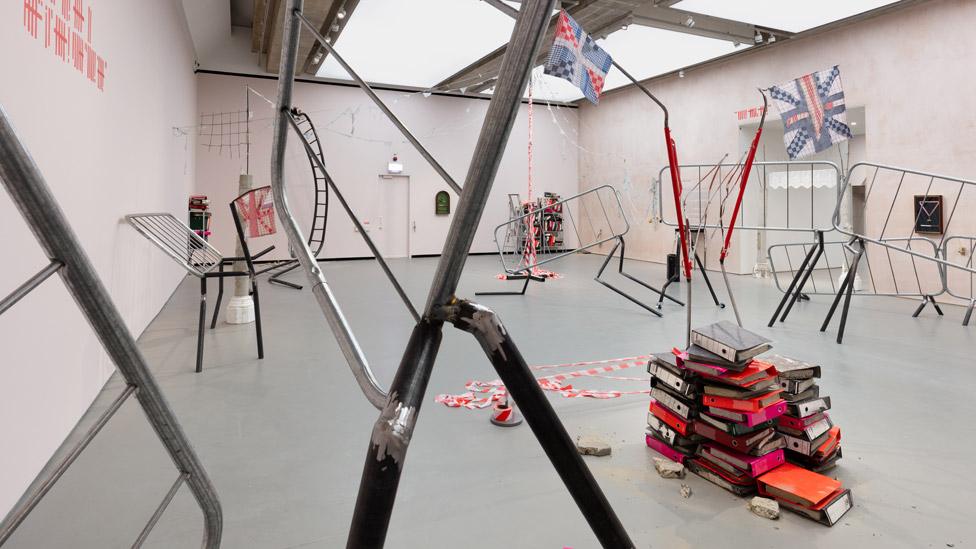Image credit: Jesse Darling | Turner Prize 2023 winner.
This year marks four decades of the Turner Prize, an anniversary which has caused many to ruminate on the way the prize has changed over the years. Many still associate the Turner Prize with the superstar artists who won it in the past – Damien Hirst, Tracey Emin, Anish Kapoor and Steve McQueen, to name a few.
The Prize is arguably less of a headline event these days, having lost the revolutionary edge that accompanied its association with groundbreaking artists like those in the YBAs. Some have complained that it is now a representation of the establishment; a complaint not without merit, although surely it must be acknowledged that any event held by the Tate would automatically be considered part of the establishment, the Tate being one of the most renowned and historic British art institutions.
Opinions on the 40th Turner Prize shortlist have, accordingly, been as strong as they are mixed, with some heralding the artists’ offerings as thought-provoking and timely commentary about British life, while others have labelled the exhibition as lacking in originality.
A heated debate, however, can breathe life into even the least interesting artworks, and the way in which the shortlisted exhibitions have provoked discussions and arguments could well be given as evidence that the prize is still relevant in its reflection of British Art and artists. The individual artists’ works have certainly much to appreciate and ponder over.
In the shortlist show, there is a definite focus on socio-political and cultural identity that connects each of the exhibitions, as well as linking to the wider practice of each artist featured. With all four artists using inspiration from their own cultural backgrounds and experiences to inspire their exhibitions, audiences are invited to explore themes of history, inheritance, belonging, and marginalisation.
Pio Abad
Abad’s exhibition comprises a range of visuals and mediums, inspired by his own upbringing in the Philippines, but with a broader focus on the dark histories of colonialism and empire from countries around the world through items in British museums. Through drawings, engravings, sculptures and etchings, Abad references many different historical moments, each linked with exploitation and theft.
Many reviewers have commented on the strong impact made by his large-scale concrete sculpture that recreates one of the jewellery items stolen by the infamous Imelda and Ferdinand Marcos when they fled from the Philippines in 1986. Other items in the exhibition have a more subtle impact, such as a series of etchings representing the tattoos of a Filipino man, Giolo, who was displayed as an attraction after being enslaved and brought to England in 1692.
Pio’s works seem to form a melancholy and thought-provoking opening to this year’s prize shortlist as visitors make their way through the suite of exhibitions.
Delaine Le Bas
Romani artist Le Bas has based her works around themes of grief and renewal, weaving in the culture and history of her heritage as well as images inspired by mythology. Her exhibition consists of immersive works, with draped painted fabrics suspended from the ceiling, as well as sculptures and costumes. The visual impact of the exhibition appears to have been mainly characterised by the artist’s self-described aesthetic of “Gipsy-hippy-punk.”
Reviewers of this year’s shortlist exhibitions have frequently referred to the large words included on the wall of Le Bas’s exhibition: “Know Thyself,” a reference to the ancient Greek Delphic oracle as well as a clear statement as to the purpose of the works surrounding it. In fact, many have commented that the words might well speak for all the artists’ works on display.
Claudette Johnson
The oldest nominee this year, Johnson’s presence in the shortlist is a reminder of the decision in 2017 to remove the 50-year-old age cap on entrants, as it was recognised that many female artists or artists from minority backgrounds may only get their break later in their career. Johnson, having originated her art practice in the Wolverhampton BLK group in the 1980s, demonstrates the value in this change.
Johnson’s exhibition consists of portraits of Black subjects, captured on a massive scale that creates a strong and classically leaning impact as she explores the complex identity of being Black and British. Her use of traditional portrait forms contrasts the Black sitters with the standard ideals of historical White portraiture.
Johnson’s combination of highly skilled realism and expressive, emotive portraiture has had many reviewers suggesting her as the favourite to win this year.
Jasleen Kaur
Kaur has received a good deal of attention from the press covering the exhibitions so far, in particular a work that features a replica of her father’s old red ford escort draped with an enormous cotton doily. The striking image has preceded many articles covering this year’s competition, although whether it affects the judges’ decision is yet to be seen.
While the Turner Prize may no longer cause the level of headline controversy that it did in its heyday, it appears that it still keeps the original intention behind the first prize awarded in 1984: to “promote public debate around new developments in contemporary British art.”
The Turner Prize also remains a huge part of the yearly art calendar, and achieving a spot on the shortlist can make the career of any artist. And, from now until December, there is sure to be much continued debate over which artist will be named the winner, and how the decision might reflect the art scene in the UK for 2024.
To get more art news and updates, make sure to subscribe to the EzelDotz newsletter and check out our blogs for more.





